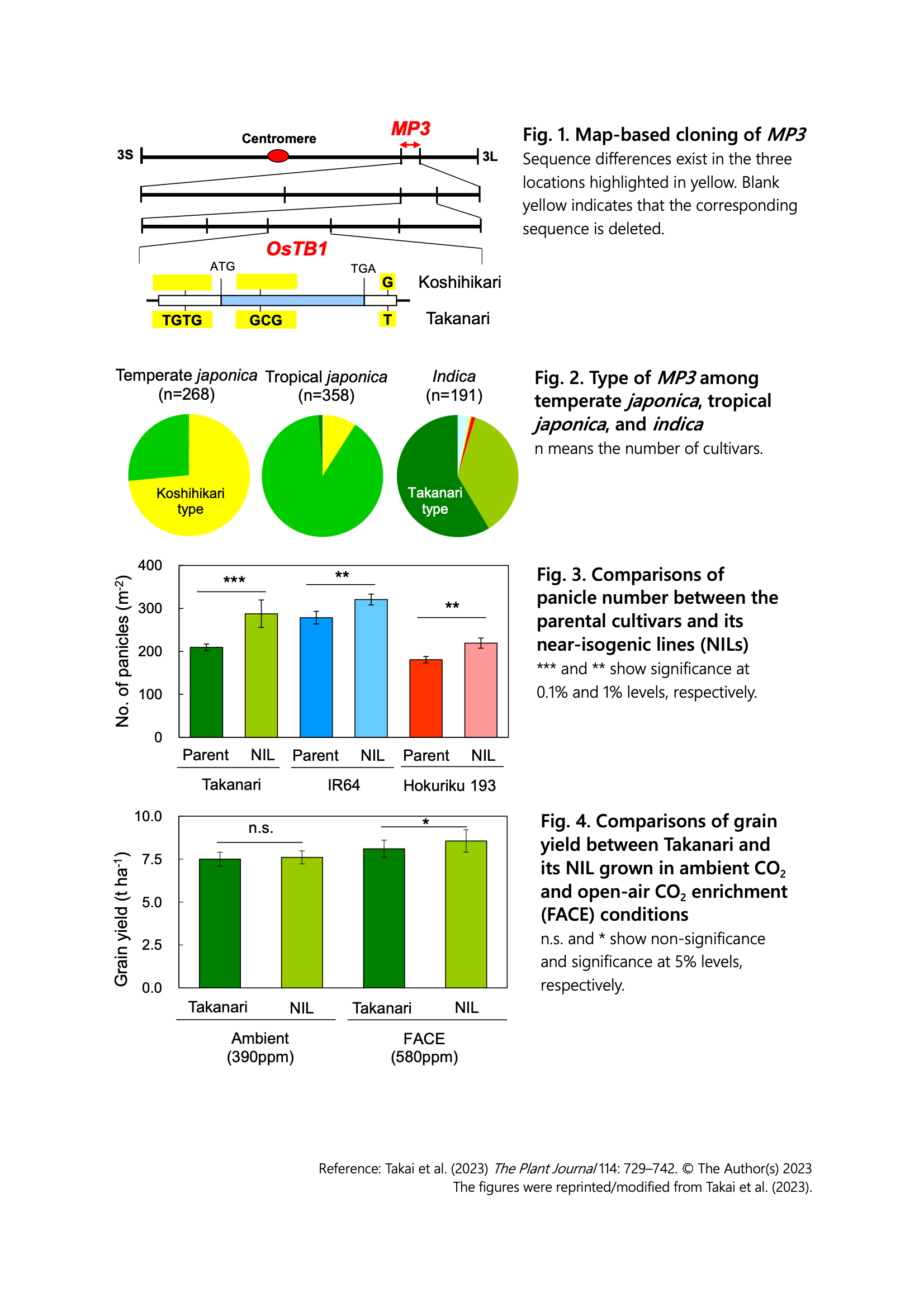A quantitative locus, MP3, which increases panicle number, enhances grain yield under an elevated atmospheric CO2 environment
Description
The atmospheric concentration of CO2, one of the greenhouse gases, is projected to reach 430ー1,000 ppm by the end of this century, increasing the average global temperature by 1.0ー5.7°C above pre-industrial levels (1850~1900). While the increase in temperature will have a negative effect on crop productivity in some regions, the increase in atmospheric CO2 concentration will have a positive effect on plant photosynthesis. Therefore, crops with sufficient spikelets to store increased photosynthetic assimilates are expected to contribute to increased yield, and the utilization of such crops under high CO2 concentrations may lead to sustainable crop production under climate change. We have previously shown that a quantitative locus, MP3 (MORE PANICLES 3), found in the temperate japonica rice cultivar Koshihikari, promotes tillering and increases panicle number in the high-yielding indica cultivar Takanari. The purpose of this study is to identify the causal gene of MP3 by map-based cloning, clarify the rice groups in which MP3 is effective, and verify that increased panicle number due to MP3 contributes to increased grain yield under an elevated atmospheric CO2 environment.We can see the results of map-based cloning in Fig. 1. The causal gene of MP3 is OsTB1 (TEOSINTE BRANCHED1) located on chromosome 3, and there are three sequence differences in the gene between Koshihikari and Takanari. Classifying rice cultivar groups based on the sequence differences, 74% of temperate japonica cultivars and 10% of tropical japonica cultivars have the same sequence as Koshihikari (Koshihikari type). On the other hand, 60% of the indica cultivars have the same sequence as Takanari (Takanari type) (Fig. 2). Then, near-isogenic lines (NILs) carrying the Koshihikari MP3 in the high-yielding indica cultivars, IR64 and Hokuriku 193, also increase panicle number by 20ー30% compared to the parental cultivars as in the case of Takanari (Fig. 3). Interestingly, Takanari-NIL enhances grain yield by 6% compared to Takanari under open-air CO2 enrichment (FACE, 580 ppm CO2 in the air), whereas it does not under ambient condition (390 ppm CO2 in the air) (Fig. 4).
Since indica cultivars are grown on more than 80% of the world's rice cropping areas, the Koshihikari MP3 is expected to be widely used in rice breeding in Japan and abroad to address climate change accompanied by rising atmospheric CO2 levels. However, it should be noted that the effect of MP3 on panicle number and grain yield under high-temperature conditions needs to be verified in the future.
Figure, table
- Research project
- Program name
- KAKEN
- Term of research
-
FY2017-2022
- Responsible researcher
-
Takai Toshiyuki ( Crop, Livestock and Environment Division )
Tsujimoto Yasuhiro ( Crop, Livestock and Environment Division )
ORCID ID0000-0001-7738-9913KAKEN Researcher No.: 20588511Asai Hidetoshi ( Crop, Livestock and Environment Division )
KAKEN Researcher No.: 30599064Kawamura Kensuke ( Social Sciences Division )
Maruyama Kyounoshin ( Biological Resources and Post-harvest Division )
Ishizaki Takuma ( Tropical Agriculture Research Front )
KOBAYASHI Nobuya ( Biological Resources Division )
Taniguchi Yojiro ( National Agriculture and Food Research Organization (NARO) )
KAKEN Researcher No.: 50462560Takahashi Megumu ( National Agriculture and Food Research Organization (NARO) )
KAKEN Researcher No.: 90739153Hirose Sakiko ( National Agriculture and Food Research Organization (NARO) )
MIERUKA ID: 1323Hara Naho ( National Agriculture and Food Research Organization (NARO) )
Sanoh-Arai Yumiko ( National Agriculture and Food Research Organization (NARO) )
KAKEN Researcher No.: 50547726Hori Kiyosumi ( National Agriculture and Food Research Organization (NARO) )
ORCID ID0000-0003-3783-9718KAKEN Researcher No.: 50442827Fukuoka Shuichi ( National Agriculture and Food Research Organization (NARO) )
SAKAI Hidemitsu ( National Institute for Agro-Environmental Sciences )
Tokida Takeshi ( National Agriculture and Food Research Organization (NARO) )
Usui Yasuhiro ( National Agriculture and Food Research Organization (NARO) )
KONDO Motohiko ( Biological Resources Division )
Hasegawa Toshihiro ( National Agriculture and Food Research Organization (NARO) )
ORCID ID0000-0001-8501-5612KAKEN Researcher No.: 10228455Uga Yusaku ( Institute of Crop Science, NARO )
Akashi Hiroko ( Yokohama City University )
Ito Jun ( Yokohama City University )
KAKEN Researcher No.: 20373269Tsuji Hiroyuki ( Yokohama City University )
ORCID ID0000-0002-6444-559XKAKEN Researcher No.: 40437512Mochida Keiichi ( RIKEN )
ORCID ID0000-0003-1299-0024KAKEN Researcher No.: 90387960Yamamoto Eiji ( Meiji University )
ORCID ID0000-0002-3095-6455KAKEN Researcher No.: 40738746Nagasaki Hideki ( Kazusa DNA Research Institute )
ORCID ID0000-0002-0020-8827KAKEN Researcher No.: 70624451Nakamura Hirofumi ( Taiyo Keiki )
- ほか
- Publication, etc.
-
Takai et al. (2023) The Plant Journal 114: 729−742.https://doi.org/10.1111/tpj.16143
- Japanese PDF
-
2023_B07_ja.pdf446.61 KB
- English PDF
-
2023_B07_en.pdf145.27 KB
* Affiliation at the time of implementation of the study.

